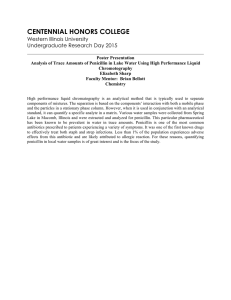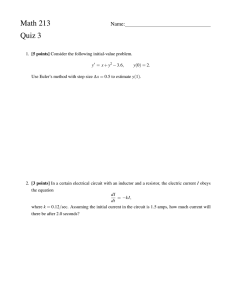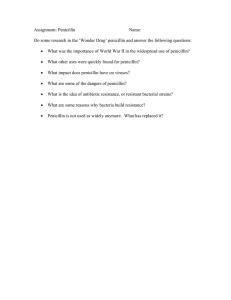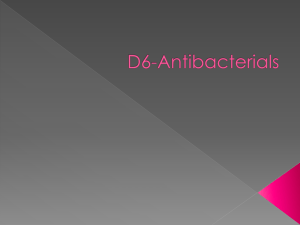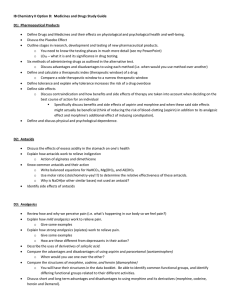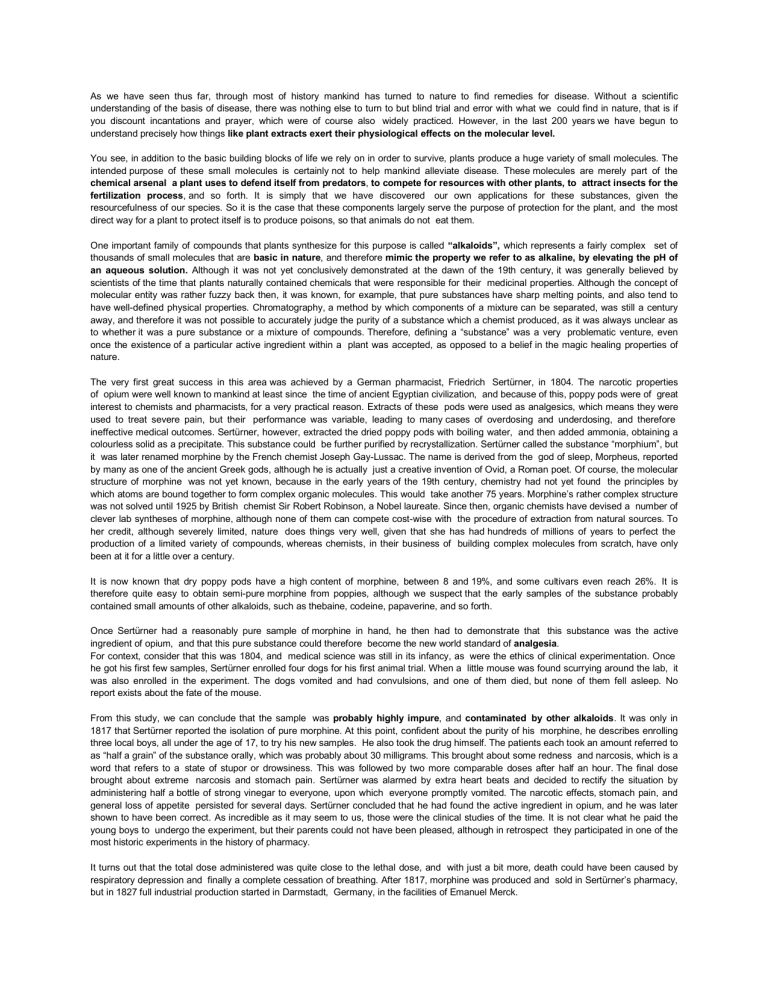
As we have seen thus far, through most of history mankind has turned to nature to find remedies for disease. Without a scientific understanding of the basis of disease, there was nothing else to turn to but blind trial and error with what we could find in nature, that is if you discount incantations and prayer, which were of course also widely practiced. However, in the last 200 years we have begun to understand precisely how things like plant extracts exert their physiological effects on the molecular level. You see, in addition to the basic building blocks of life we rely on in order to survive, plants produce a huge variety of small molecules. The intended purpose of these small molecules is certainly not to help mankind alleviate disease. These molecules are merely part of the chemical arsenal a plant uses to defend itself from predators, to compete for resources with other plants, to attract insects for the fertilization process, and so forth. It is simply that we have discovered our own applications for these substances, given the resourcefulness of our species. So it is the case that these components largely serve the purpose of protection for the plant, and the most direct way for a plant to protect itself is to produce poisons, so that animals do not eat them. One important family of compounds that plants synthesize for this purpose is called “alkaloids”, which represents a fairly complex set of thousands of small molecules that are basic in nature, and therefore mimic the property we refer to as alkaline, by elevating the pH of an aqueous solution. Although it was not yet conclusively demonstrated at the dawn of the 19th century, it was generally believed by scientists of the time that plants naturally contained chemicals that were responsible for their medicinal properties. Although the concept of molecular entity was rather fuzzy back then, it was known, for example, that pure substances have sharp melting points, and also tend to have well-defined physical properties. Chromatography, a method by which components of a mixture can be separated, was still a century away, and therefore it was not possible to accurately judge the purity of a substance which a chemist produced, as it was always unclear as to whether it was a pure substance or a mixture of compounds. Therefore, defining a “substance” was a very problematic venture, even once the existence of a particular active ingredient within a plant was accepted, as opposed to a belief in the magic healing properties of nature. The very first great success in this area was achieved by a German pharmacist, Friedrich Sertürner, in 1804. The narcotic properties of opium were well known to mankind at least since the time of ancient Egyptian civilization, and because of this, poppy pods were of great interest to chemists and pharmacists, for a very practical reason. Extracts of these pods were used as analgesics, which means they were used to treat severe pain, but their performance was variable, leading to many cases of overdosing and underdosing, and therefore ineffective medical outcomes. Sertürner, however, extracted the dried poppy pods with boiling water, and then added ammonia, obtaining a colourless solid as a precipitate. This substance could be further purified by recrystallization. Sertürner called the substance “morphium”, but it was later renamed morphine by the French chemist Joseph Gay-Lussac. The name is derived from the god of sleep, Morpheus, reported by many as one of the ancient Greek gods, although he is actually just a creative invention of Ovid, a Roman poet. Of course, the molecular structure of morphine was not yet known, because in the early years of the 19th century, chemistry had not yet found the principles by which atoms are bound together to form complex organic molecules. This would take another 75 years. Morphine’s rather complex structure was not solved until 1925 by British chemist Sir Robert Robinson, a Nobel laureate. Since then, organic chemists have devised a number of clever lab syntheses of morphine, although none of them can compete cost-wise with the procedure of extraction from natural sources. To her credit, although severely limited, nature does things very well, given that she has had hundreds of millions of years to perfect the production of a limited variety of compounds, whereas chemists, in their business of building complex molecules from scratch, have only been at it for a little over a century. It is now known that dry poppy pods have a high content of morphine, between 8 and 19%, and some cultivars even reach 26%. It is therefore quite easy to obtain semi-pure morphine from poppies, although we suspect that the early samples of the substance probably contained small amounts of other alkaloids, such as thebaine, codeine, papaverine, and so forth. Once Sertürner had a reasonably pure sample of morphine in hand, he then had to demonstrate that this substance was the active ingredient of opium, and that this pure substance could therefore become the new world standard of analgesia. For context, consider that this was 1804, and medical science was still in its infancy, as were the ethics of clinical experimentation. Once he got his first few samples, Sertürner enrolled four dogs for his first animal trial. When a little mouse was found scurrying around the lab, it was also enrolled in the experiment. The dogs vomited and had convulsions, and one of them died, but none of them fell asleep. No report exists about the fate of the mouse. From this study, we can conclude that the sample was probably highly impure, and contaminated by other alkaloids. It was only in 1817 that Sertürner reported the isolation of pure morphine. At this point, confident about the purity of his morphine, he describes enrolling three local boys, all under the age of 17, to try his new samples. He also took the drug himself. The patients each took an amount referred to as “half a grain” of the substance orally, which was probably about 30 milligrams. This brought about some redness and narcosis, which is a word that refers to a state of stupor or drowsiness. This was followed by two more comparable doses after half an hour. The final dose brought about extreme narcosis and stomach pain. Sertürner was alarmed by extra heart beats and decided to rectify the situation by administering half a bottle of strong vinegar to everyone, upon which everyone promptly vomited. The narcotic effects, stomach pain, and general loss of appetite persisted for several days. Sertürner concluded that he had found the active ingredient in opium, and he was later shown to have been correct. As incredible as it may seem to us, those were the clinical studies of the time. It is not clear what he paid the young boys to undergo the experiment, but their parents could not have been pleased, although in retrospect they participated in one of the most historic experiments in the history of pharmacy. It turns out that the total dose administered was quite close to the lethal dose, and with just a bit more, death could have been caused by respiratory depression and finally a complete cessation of breathing. After 1817, morphine was produced and sold in Sertürner’s pharmacy, but in 1827 full industrial production started in Darmstadt, Germany, in the facilities of Emanuel Merck. The Merck pharmacy had been founded in Darmstadt in 1668, but had remained a small business until Emanuel Merck recognized the potential of active principles from plants. The company grew markedly by selling morphine, which they described to be part of a new “cabinet of pharmaceutical and chemical innovations”, and gradually became the pharmaceutical giant and successful research and development center of later centuries. Morphine is still an important drug today, and therefore an important commercial product. Its production volume is over 500 metric tons per year, which is about one million pounds. However, much of this is used to prepare what are referred to as semisynthetic derivatives, where chemists begin with a natural product and tinker with its structure. As we will discuss when we talk about the modern pharmaceutical industry, chemists always play with the structures of bioactive natural products, adding or removing functionality to see what the transformation does to the molecule’s biological activities. Therefore, there are many important synthetic derivatives of morphine. ➢ A transformation we refer to as double acetylation, for example, gives rise to a more potent derivative of morphine, called heroin. Just as with morphine, heroin is very addictive and has caused many societal problems, and we will discuss this further in a chapter on narcotics. ➢ Other morphine derivatives, like codeine and hydrocodone, are sold as potent analgesics and have a wide market. This group of substances is called “opioids” and unfortunately also gives rise to complex dependency patterns. Merck and other firms took advantage of the alkaloid business and developed other products, although none of them reached the volume of morphine. There are literally thousands of alkaloids in nature, and you may have heard of some of them. ➢ Most of them are poisons, like strychnine, and coniine, the active principles of hemlock, the plant which was used to execute Socrates in ancient Greece. You have certainly heard of nicotine, another extremely toxic alkaloid found in tobacco, and widely debated substance. Caffeine is the alkaloid of tea and coffee, and it is also poisonous at high doses. Some alkaloids, like the 1,2-unsaturated pyrrolizidine alkaloids, are also carcinogenic, meaning cancer-causing. Unfortunately, these are contained in over 1,000 plants, and can represent a significant cancer risk when inadvertently processed for food along with edible plants. Furthermore, some of the plants containing this carcinogenic alkaloid, like borage, are themselves considered edible plants. To summarize the key points of what we have just discussed, some plants naturally produce a structurally varied series of compounds called alkaloids, which they primarily use as a defense mechanism. As these alkaloids have biological properties and interfere with a number of biological pathways with the ultimate goal of killing predators, it is logical that a few might have medicinal applications of some sort or another, and this application was exploited to advance the field of medicine, and set the stage for the pharmaceutical industry. But morphine is not the only compound in this story. Next we will provide one more example, a compound which is more directly credited with birthing the modern pharmaceutical industry via an unpredictable series of events. Let’s see what happened next in the history of drugs. ALEXANDER FLEMING – Penicillin London, 1928: a group of mold spores surf a breeze through a lab. They drift onto a petri dish, and when they land, they germinate a medical revolution. This lab belongs to Alexander Fleming, a Scottish scientist investigating the properties of infectious bacteria. At this time, Fleming is away on vacation. When he returns, he finds a colony of mold growing on a petri dish he’d forgotten to place in his incubator. And around this colony of mold is a zone completely and unexpectedly clear of bacteria. In studying this mysterious phenomenon, Fleming came to realize that the mold was secreting some kind of compound that was killing the bacteria. The mold was a species in the Penicillium genus, so Fleming dubbed the antibacterial compound “penicillin.” What Fleming stumbled upon was a microbial defense system. The penicillium mold constantly produces penicillin in order to defend itself from threats, such as nearby bacterial colonies that might consume its resources. Penicillin destroys many types of bacteria by disrupting synthesis of their cell walls. These walls get their strength from a thick, protective mesh of sugars and amino acids, that are constantly being broken down and rebuilt. Penicillin binds to one of the compounds that weaves this mesh together and prevents the wall from being reconstructed at a critical phase. Meanwhile, penicillin stimulates the release of highly reactive molecules that cause additional damage. Eventually, the cell’s structure breaks down completely. This two-pronged attack is lethal to a wide range of bacteria, whether in petri-dishes, our bodies, or elsewhere. It’s not, however, harmful to our own cells, because those don’t have cell walls. For a decade or so after Fleming’s discovery, penicillin remained a laboratory curiosity. But during World War II, researchers figured out how to isolate the active compound and grow the mold in larger quantities. They then went on to win the Nobel Prize for their work. Teams at Oxford and several American drug companies continued development, and within a few years it was commercially available. Penicillin and similar compounds quickly transformed the treatment of infections. For the time being, they remain some of the most important, life-saving antibiotics used in medicine. However, the more we use any antibiotic, the more bacteria evolve resistance to it. In the case of penicillin, some bacteria produce compounds that can break down the key structure that interferes with cell wall synthesis. As antibiotic use has increased, more and more bacteria have evolved this defense, making these antibiotics ineffective against a growing number of bacterial infections. This means it’s essential that doctors do not overprescribe the drug. Meanwhile, 5 to 15% of patients in developed countries self-identify as allergic to penicillin, making it the most commonly reported drug allergy. However, the vast majority— over 90%— of people who think they’re allergic to penicillin actually are not. Why the misperception? Many patients acquire the allergy label as children, when a rash appears after they’re treated for an infection with penicillin or closely related drugs. The rash is often blamed on penicillin, while the more likely culprit is the original infection, or a reaction between the infection and the antibiotic. However, genuine penicillin allergies, where our immune systems mistake penicillin for an attacker, do occur rarely and can be very dangerous. So if you think you’re allergic but don’t know for sure, your best bet is to visit an allergist. They’ll complete an evaluation that’ll confirm whether or not you have the allergy. Even if you do have a penicillin allergy, your immune cells that react to the drug may lose their ability to recognize it. In fact, about 80% of people who are allergic to penicillin outgrow their allergy within ten years. This is great news for people who currently identify as allergic to penicillin; the drug may one day save their lives, as it has done for so many others.
